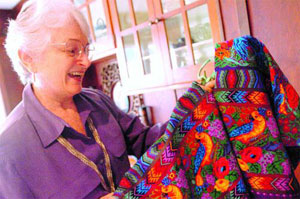Endangered Threads
Vitale weaves Mayan culture into documentary
By RICH FREEDMAN/Times-Herald staff writer
March 9, 2008 - Corrected by Kathleen Mossman Vitale 4/30/2008
 Kathleen Mossman Vitale has a reservoir of knowledge about Mayan weaving. And years of experience as a video journalist.
Kathleen Mossman Vitale has a reservoir of knowledge about Mayan weaving. And years of experience as a video journalist.
But that hardly made the Endangered Threads documentary "A Century of Color" a breeze to film.
"Everything about this project was a challenge," Vitale said. "Traveling in unfamiliar territory where many of the weavers spoke not a word of Spanish - only one of more than 20 Mayan languages. Overcoming their fear of outsiders after a recent devastating Civil War; getting permission from museums for the use of photos and objects, finding volunteers; making Spanish and English narration tracks fit the same visuals; and, especially, getting funds."
Nothing, she said, was easy.
Between 2004 and 2007, it took 124 days in Guatemala to get the required footage, Vitale said, filming 91 weavers between the ages of 8 and 80 and interviewing dozens of people while visiting 52 indigenous communities.
Gratefully, Vitale said a $10,000 grant helped pay for post-production expenses along with a fundraiser by Vallejo High School graduates Eleanor Erickson Irvin and Sandra Kilpatrick Petty.
 "The biggest challenge was finishing a subject covering 100 years," said Vitale, who told her husband, Paul, "I won't take on 100 years
of anything else," though "I naturally have half a dozen shorter projects in the wings."
"The biggest challenge was finishing a subject covering 100 years," said Vitale, who told her husband, Paul, "I won't take on 100 years
of anything else," though "I naturally have half a dozen shorter projects in the wings."
Fortunately, what may be a lost art is not a dead art, Vitale said.
"Maya weaving is alive and well in the highlands of Guatemala," she said. "It's just changing and changing very rapidly."
Originally, the weaving was clothing and home accessories. Designs and styles were unique to each community, Vitale said.
"Now, as cheap clothing from Asia and used clothing from the states flood the markets, it's harder to rationally spend up to three months to produce a beautifully woven blouse or a pair of pants when you can buy used ones for practically nothing,"
Jeans and T-shirts, added Vitale, can be seen on even the most expert weaver's children.
"What many weavers are concentrating on now is producing items for foreign tastes," she said. "Such as table runners and scarves. Things that can bring in money to help fund medicine and education for their children, which were not accessible in the past."
Still, said Vitale, "I can't help fearing that 10 years from now much of the color and uniqueness of Maya dress will be a thing of the past, casualties of urbanization, globalization and modernization."
Vitale became interested in the video project after a visit to the Hearst Museum of Anthropology at UC-Berkeley, were she was arranging the gift of her mother's 700 piece textile collection from around the world.
"My eyes were drawn to a group of Native Americans silently looking at a most beautiful basket on display," Vitale said. "It hit me as sad that there was not a documentary that could show them who had made the basket, how it was wove, what kind of creative energies went into selecting the soft feathers and colorful shells affixed to the sides, and how it was intended to be used."
The challenge of producing a documentary led to establishing an educational nonprofit.
"We decided to cover 100 years of Maya weaving for two reasons," Vitale said. "To the best of our knowledge, it had never been done in a documentary format, and a preeminent U.S. collection of Maya weaving dating from the turn of the last century was at the Hearst Museum."
Through the Vitales many visits to Maya weavers, they were often amazed a the complex designs and intricate weaving techniques of the art form.
"Normally shy and reserved, the weavers relaxed and showed by their comments with family members that they were proud of their work," Vitale said. "Weaving is physical labor, but it is also a creative mental challenge remembering the patterns and weaving styles. The sense of accomplishment is visceral. Most Maya weavers have no formal education. Weaving is what they know. Weaving is part of their self-worth, an art form they know well that has practical significance. Pride is heritage. Machine produced cloth will never match that."
The Mayans, said Vitale, "willingly allowed us into their homes, shared their hopes and dreams with us and allowed us to film them. This is their story."
"Century of Color" is being used by an education foundation in Guatemala as part of a program to teach Maya culture to Maya children and the documentary premiered at the National Hispanic Culture Center in Albuquerque, N.M., last November.
It will be showed at the deYoung Museum in San Francisco on Sept. 13 as a fund-raiser for the Textile Arts Council. A clip will be shown on Univision Channel 14 on March 19.
"I think there are things to be learned from native cultures about beauty and about craftsmanship," Vitale said. "And I think the world would be a far lesser place without Maya weaving in Guatemala."
For a copy of the DVD or for more information, visit endangeredthreads.com.
